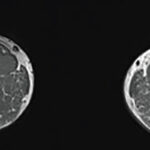Ericsson and her coauthors studied patients who had undergone arthroscopic meniscectomy one to six years previously, when the subjects ranged from 35 to 45. They compared muscle strength and functional performance in the operated and unoperated legs, and had each patient complete the Knee Injury and Osteoarthritis Outcome Score (KOOS)—a questionnaire that asks about pain and other symptoms, function in sport and recreation, activities of daily living, and knee-related quality of life. Scores range from 100 (no symptoms) to 0 (extreme symptoms).
A total of 29 men and 16 women participated in the study. Their mean age was 45.7, with a mean time from surgery of four years. They had a mean body mass index of 26.5 kg/m2, and 33 reported some pain in the operated knee. Overall, isokinetic knee extensor strength was significantly less for the operated compared to the non-operated leg (p<0.02). The operated knee also performed less well on the one-leg rising test, another test of knee and hip extensor strength (p=0.004).
Scores on all components of the KOOS were worse for these patients than for age-matched, healthy control subjects (<0.001). Their scores on the pain and quality-of-life scales were similar to those of post-meniscectomy patients who developed post-traumatic osteoarthritis, an unexpected finding, Ericsson tells The Rheumatologist. The patients in this study scored higher (better) on the scales measuring symptoms, activities of daily living, and sport and recreational activities.
Mensicectomy patients are usually prescribed a home exercise program after surgery, but they generally do not undergo supervised physical therapy. The findings of this study “do not allow us to make any inferences about a general need for supervised physical therapy,” says Ericsson. “Yet our findings that patients have low self-perceived function and that this is related to their strength deficit suggests that restoration of full muscle strength is important, and that some patients might benefit from muscle training.”
Norra MacReady is a medical journalist based in southern California.

